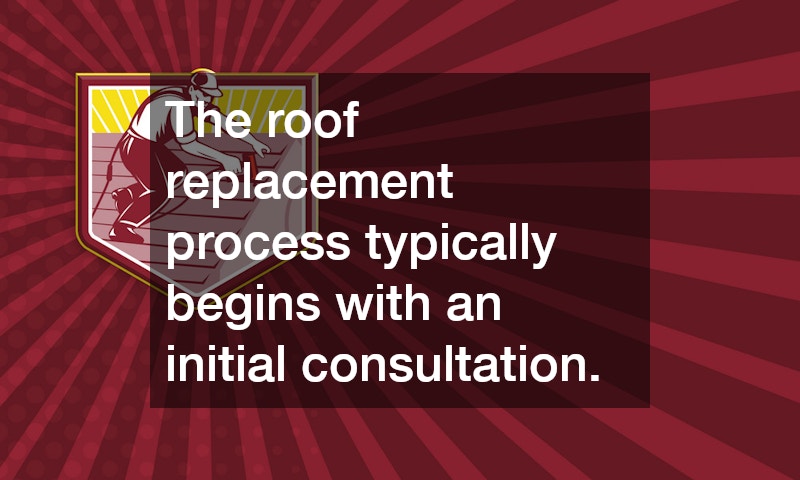
Undergoing a roof replacement is a significant investment and a substantial home improvement project. Understanding the process can ease your mind and ensure you are prepared for what lies ahead. In this article, we’ll delve into the various stages of a roof replacement, highlight the importance of professional roof replacement services, and provide tips for preparing your home and family.
Initial Consultation and Inspection
The roof replacement process typically begins with an initial consultation. During this stage, a representative from the roof replacement services company will visit your home to assess your current roof’s condition.
They will inspect for damage, wear, and any underlying issues that might necessitate a replacement. This inspection is crucial as it determines the scope of work and influences the overall estimate. You will also have the opportunity to discuss your preferences, expectations, and any questions you might have regarding materials, design, and costs.
Following the inspection, the contractor will provide a detailed estimate and scope of work. This document will outline the materials needed, labor costs, and a timeline for the project. It’s essential to review this estimate carefully and compare it with other quotes if necessary. The consultation phase is the perfect time to inquire about the company’s credentials, insurance, and any warranties they offer. Professionalism and transparency during this phase can set the tone for a successful roof replacement project.
Once you agree on terms, the next step is to schedule the replacement. Availability might depend on the season and weather conditions, as certain conditions are more conducive to roofing work. The contractor will coordinate logistics, including obtaining any necessary permits. This phase sets the stage for the physical work to begin and ensures that you understand what to expect in the coming weeks. Preparing ahead can greatly minimize surprises and disruptions during the actual roofing process.
Preparation and Material Delivery
Before the contractors begin work, there is a crucial preparation stage that takes place. It involves clearing the area around your home to protect valuables from dust and debris. It is advisable to remove items such as patio furniture, grills, and potted plants to safe locations. This not only protects your belongings but also provides ample space for workers to move freely. Additionally, your home’s attic should be covered with a tarp to shield stored items from falling debris.
Material delivery usually happens a few days before the scheduled start date. The roofing company will coordinate the delivery of essential materials such as shingles, underlayment, and flashing. These materials are often stored on your driveway or another dedicated area for easy access. The delivery ensures that there are no delays once the roof replacement begins. Ensuring that the materials match your preferred color and style options is important to align with your vision.
Communication with the roofing company is key during this stage. Ensure that you have a clear understanding of the start date, the projected duration of the project, and any specific instructions you need to follow. This clarity helps in minimizing any disruptions and ensures the project proceeds smoothly. Regular updates from the contractor keep you informed and engaged with the progress. Establishing a line of communication fosters a collaborative relationship between you and the roof replacement services provider.
Removing the Old Roof
The physical work of roof replacement commences with removing the old roof. This labor-intensive process involves stripping off existing shingles or roofing materials. It may also necessitate the removal of underlayment and other layers down to the roof deck. This removal phase is typically noisy and might cause vibrations throughout the house. It’s advisable for homeowners to prepare for some disruption during this part of the process and find ways to manage noise and dust.
Critical during removal is identifying underlying issues that may not have been visible during the initial inspection. Contractors will check the roof deck for signs of rot, mold, or damage. Addressing these structural issues is essential for the longevity and integrity of the new roof. This step emphasizes the importance of professional roof replacement services, as experienced contractors will know what to look for and how to address any problems effectively. Ignoring these issues could lead to premature roof failure in the future.
The removal phase also includes disposing of the old materials. Most roofing contractors will handle this aspect, ensuring that waste is properly managed and recycled when possible. This step is crucial from an environmental standpoint, as it minimizes the ecological footprint of your roof replacement project. Understanding the disposal process and procedures is an essential part of the planning phase. It is often included in the project’s estimate, ensuring no surprises regarding additional costs.
Installation of New Roofing Materials
Once the old roof is removed, the installation of new roofing materials begins. This phase involves laying down underlayments as the first protective barrier against moisture. Following this, the installation of shingles or other chosen materials takes place. The process is meticulous and requires precision to ensure proper alignment and adherence. Professional roof replacement services are invaluable during this stage due to their expertise and ability to tackle complex roofing systems.
The choice of materials significantly influences the aesthetic and functional qualities of your new roof. Discuss options with your contractor to choose the best fit for your climate, style, and budget. Common materials include asphalt shingles, metal roofing, and tiles, each having unique benefits and lifespans. The quality of installation will impact the roof’s performance and durability, emphasizing the importance of selecting experienced professionals for the job. Warranty options often depend on the materials chosen, so it’s crucial to understand what each offers.
Installation might require additional components such as flashing around chimneys, vents, and edges to prevent leaks. These elements are vital in ensuring that the roof is leak-proof and can withstand harsh weather conditions. Professional roofers have the skills and tools required to install these elements correctly. By entrusting your roof replacement to a skilled team, you ensure the safety and protection of your home from the elements. Knowing that your roof is installed correctly grants peace of mind long after the project is complete.
Final Inspection and Clean-Up
After installation, a final inspection occurs to verify that all work meets current standards and specifications. The roofing company ensures that all components are securely installed and checks for potential weak spots. This final check is crucial in identifying any elements that may need adjustments before the project’s completion. A thorough inspection guarantees the longevity and reliability of your new roof. Reputable roof replacement services will take the time to conduct this final oversight, ensuring customer satisfaction.
Once the inspection is complete, the clean-up phase begins. This involves removing any debris, stray nails, and materials from your property. The goal is to leave the site as clean as it was before the project began. Professional roofing companies are efficient and thorough, using specialized equipment such as magnetic tools to ensure no hazardous elements are left behind. A clean site reflects the quality of work and respect the contractors have for your property.
The completion of your roof replacement marks the start of a new era of protection for your home. With enhanced energy efficiency, better aesthetic appeal, and increased property value, a new roof is a wise investment. Engaging professional roof replacement services ensures that the transition from your old roof to the new is seamless and stress-free. The final step includes discussing any maintenance tips and scheduling follow-up inspections, ensuring your roof remains in top condition for years to come.

